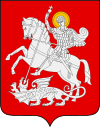Tbilisi
Tbilisi (English: /təbɪˈliːsi, təˈbɪlɪsi/ tə-bih-LEE-see, tə-BIL-ih-see;[7] Georgian: თბილისი [tʰbilisi] (![]()
Tbilisi თბილისი | |
|---|---|
Capital city | |
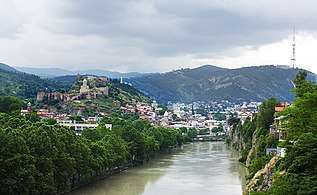 .jpg)   .jpg) .jpg) Left to right: View of Tbilisi, Holy Trinity Cathedral (Sameba), Kartlis Deda, Abanotubani, view from Narikala, Narikala Fortress | |
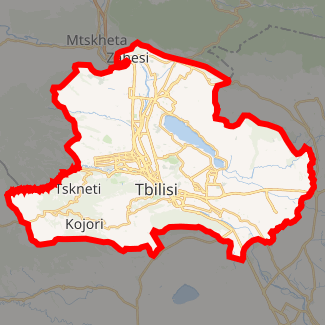
| |
 Tbilisi  Tbilisi 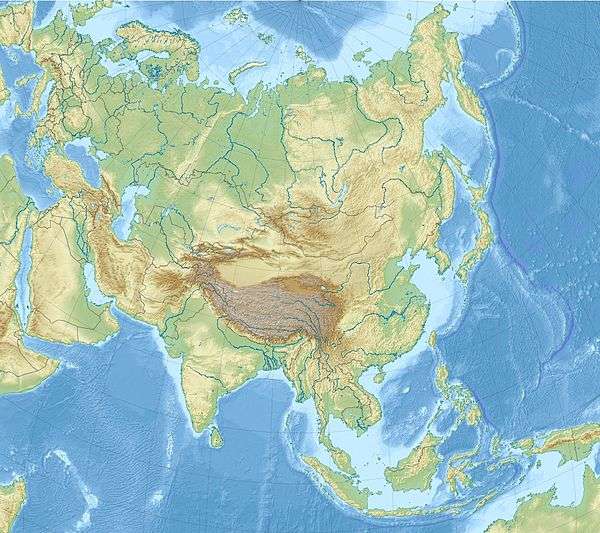 Tbilisi | |
| Coordinates: 41°43′21″N 44°47′33″E | |
| Country | |
| Established | AD 455[1] |
| Government | |
| • Mayor | Kakha Kaladze[2] |
| Area | |
| • Capital city | 504.2 km2 (194.7 sq mi) |
| Highest elevation | 770 m (2,530 ft) |
| Lowest elevation | 380 m (1,250 ft) |
| Population (2019) | |
| • Capital city | 1,171,100[4] |
| • Density | 3,194.38/km2 (8,273.4/sq mi) |
| • Metro | 1,485,293 |
| Demonym(s) | Tbilisian Tbilisite |
| Time zone | UTC+4 (Georgian Time) |
| Area code(s) | +995 32 |
| GRP[5] | 2019 |
| – Total | GEL23.1bil. ($9B) |
| – Per capita | GEL19,470 ($7757) |
| HDI (2018) | 0.864[6] – very high |
| Website | http://www.tbilisi.gov.ge/ |
Because of its location on the crossroads between Europe and Asia, and its proximity to the lucrative Silk Road, throughout history Tbilisi was a point of contention among various global powers. The city's location to this day ensures its position as an important transit route for energy and trade projects. Tbilisi's history is reflected in its architecture, which is a mix of medieval, neoclassical, Beaux Arts, Art Nouveau, Stalinist and the Modern structures.
Historically, Tbilisi has been home to people of multiple cultural, ethnic, and religious backgrounds, though it is overwhelmingly Eastern Orthodox Christian. Its notable tourist destinations include cathedrals Sameba and Sioni, Freedom Square, Rustaveli Avenue and Agmashenebeli Avenue, medieval Narikala Fortress, the pseudo-Moorish Opera Theater, and the Georgian National Museum. The climate in Tbilisi mostly ranges from 20 to 32 °C (68 to 90 °F) in the summer and 7 to −1 °C (45 to 30 °F) in the winter.
Names and etymology
The name Tbilisi derives from Old Georgian t′bilisi (Asomtavruli: ႲႡႨႪႨႱႨ, Mkhedruli: თბილისი), and further from tpili (Modern Georgian: თბილი, 'warm', itself from Old Georgian: ႲႴႨႪႨ ṭpili). The name T′bili or T′bilisi (literally, 'warm location') was therefore given to the city because of the area's numerous sulfuric hot springs.
Until 1936, the name of the city in English and most other languages was Tiflis, while the Georgian name was ტფილისი (Tpilisi).[9]
On 17 August 1936, by order of the Soviet leadership, the official Russian names of various cities were changed to more closely match the local language.[9] In addition, the Georgian-language form T′pilisi was modernized on the basis of a proposal by Georgian linguists; the ancient Georgian component ტფილი (tpili, 'warm') was replaced by the newer თბილი (t′bili).[9] This form was the basis for a new official Russian name (Тбилиси Tbilisi). Most other languages have subsequently adopted the new name form, but some language such as Turkish, Persian, Greek, and German have retained a variation of Tiflis.
On 20 September 2006, the Georgian parliament held a ceremony celebrating the 70th anniversary of the renaming.
Some of the traditional names of Tbilisi in other languages of the region have different roots. The Ossetian name Калак (Kalak) derives from the Georgian word ქალაქი (kalaki) meaning simply 'town'. Chechen and Ingush names for the city use a form similar to or the same as their names for the country of Georgia (Гуьржех Gürƶex) as does the historical Kabardian name (Курджы Kwrdžə), while Abkhaz Қарҭ (Ķarţ) is from the Mingrelian ქართი (Karti).
History
Early history
Archaeologists discovered evidence of continuous habitation of the Tbilisi suburb of Dighomi since the early Bronze Age, and stone artifacts dating to the Paleolithic age.[10] During the late Bronze Age to early Iron Age, it was the largest settlement in the Caucasus.[11] According to legend, the present-day territory of Tbilisi was covered by forests as late as 458. One widely accepted variant of the Tbilisi foundation myth states that King Vakhtang I of Iberia (r. c. 447/49 – 502/22) went hunting in the heavily wooded region with a falcon (sometimes the falcon is replaced with either a hawk or other small birds of prey in the legend). The King's falcon allegedly caught or injured a pheasant during the hunt, after which both birds fell into a nearby hot spring and died from burns. King Vakhtang became so impressed with the hot springs that he decided to clear the forest and build a city on the location.
King Dachi of Iberia (r. 522–534), the successor of Vakhtang I, moved the capital of Iberia from Mtskheta to Tbilisi and began construction of the fortress wall that lined the city's new boundaries.[12] From the 6th century, Tbilisi grew at a steady pace due to the region's strategic location along important trade and travel routes between Europe and Asia.
Foreign domination

Tbilisi's favorable trade location, however, did not necessarily bode well for its survival. Located strategically in the heart of the Caucasus between Europe and Asia, Tbilisi became an object of rivalry among the region's various powers such as the Roman Empire, Parthia, Sassanid Persia, Muslim Arabs, the Byzantine Empire, and the Seljuk Turks. The cultural development of the city was somewhat dependent on who ruled the city at various times, although Tbilisi was fairly cosmopolitan.
From 570–580, the Persians ruled the city until 627, when Tbilisi was sacked by the Byzantine/Khazar armies and later, in 736–738, Arab armies entered the town under Marwan II. After this point, the Arabs established an emirate centered in Tbilisi. In 764, Tbilisi – still under Arab control – was once again sacked by the Khazars. In 853, the armies of Arab leader Bugha Al-Turki invaded Tbilisi in order to enforce its return to Abbasid allegiance. The Arab domination of Tbilisi continued until about 1050. In 1068, the city was once again sacked, only this time by the Seljuk Turks under Sultan Alp Arslan.
Capital of Georgia
In 1121, after heavy fighting with the Seljuks, the troops of the King of Georgia David IV of Georgia besieged Tbilisi, which ended in 1122 and as a result David moved his residence from Kutaisi to Tbilisi, making it the capital of a unified Georgian State and thus inaugurating the Georgian Golden Age. From 12–13th centuries, Tbilisi became a regional power with a thriving economy and astonishing cultural output. By the end of the 12th century, the population of Tbilisi had reached 100,000. The city also became an important literary and a cultural center not only for Georgia but for the Eastern Orthodox world of the time. During Queen Tamar's reign, Shota Rustaveli worked in Tbilisi while writing his legendary epic poem, The Knight in the Panther's Skin. This period is often referred to as "Georgia's Golden Age"[13] or the Georgian Renaissance.[14]
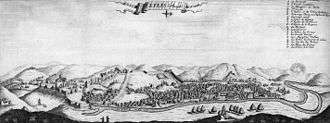
Mongol domination and the following period of instability
Tbilisi's "Golden Age" did not last for more than a century. In 1226, Tbilisi was captured by the Khwarezmian Empire Shah Jalal ad-Din and its defences severely devastated and prone to Mongol armies. In 1236, after suffering crushing defeats to the Mongols, Georgia came under Mongol domination. The nation itself maintained a form of semi-independence and did not lose its statehood, but Tbilisi was strongly influenced by the Mongols for the next century both politically and culturally. In the 1320s, the Mongols retreated from Georgia and Tbilisi became the capital of an independent Georgian state once again. An outbreak of the plague struck the city in 1366.
From the late 14th until the end of the 18th century, Tbilisi came under the rule of various foreign invaders once again and on several occasions was completely burnt to the ground. In 1386, Tbilisi was invaded by the armies of Tamerlane. In 1444, the city was invaded and destroyed by Jahan Shah (the Shah of the town of Tabriz in Persia). From 1477 to 1478 the city was held by the Ak Koyunlu tribesmen of Uzun Hassan.
Iranian control

As early as the 1510s, Tbilisi (and the kingdoms of Kartli and Kakheti) were made vassal territories of Safavid Iran.[15] In 1522, Tbilisi was garrisoned for the first time by a large Safavid force.[16][17] Following the death of king (shah) Ismail I (r. 1501–1524), king David X of Kartli expelled the Iranians. During this period, many parts of Tbilisi were reconstructed and rebuilt. The four campaigns of king Tahmasp I (r. 1524–1576) resulted in the reoccupation of Kartli and Kakheti, and a Safavid force was permanently stationed in Tbilisi from 1551 onwards.[16][18] With the 1555 Treaty of Amasya, and more firmly from 1614 to 1747, with brief intermissions, Tbilisi was an important city under Iranian rule, and it functioned as a seat of the Iranian vassal kings of Kartli whom the shah conferred with the title of vali. Under the later rules of Teimuraz II and Heraclius II, Tbilisi became a vibrant political and cultural center free of foreign rule—but, fearful of the constant threat of invasion, Georgia's rulers sought Russian protection in the 1783 Treaty of Georgievsk. Despite this agreement, the city was captured and devastated in 1795 by the Iranian Qajar ruler Agha Mohammad Khan, who sought to re-establish Iran's traditional sovereignty over the region.[19][20][21]
Russian control
.png)
In 1801, the Russian Empire annexed the Georgian kingdom of Kartli-Kakheti (of which Tbilisi was the capital), later cementing its rule with the Treaty of Gulistan of 1813,[22][23] which ended Iranian control of Georgia.[24] Tbilisi became the center of the Tbilisi Governorate (Gubernia). Russian Imperial administrators implemented a new European-style city plan and commissioned new buildings in Western styles. Roads and railroads were built to connect Tbilisi to other important cities in the Russian Empire, such as Batumi and Poti. By the 1850s, Tbilisi once again emerged as a major trade and a cultural center. The likes of Ilia Chavchavadze, Akaki Tsereteli, Mirza Fatali Akhundzade, Iakob Gogebashvili, Alexander Griboyedov and many other statesmen, poets and artists all found their home in Tbilisi. The city was visited on numerous occasions by and was the object of affection of Alexander Pushkin, Leo Tolstoy, Mikhail Lermontov, the Romanov family and others. The main new artery built under Russian administration was Golovin Avenue (present-day Rustaveli Avenue), on which the Viceroys of the Caucasus established their residence. For much of the 19th century, Tbilisi's largest ethnic group was Armenian, who, at some point, formed 74.3% of the population.[25]
 "Dry Bridge", constructed by Italian architect Antonio Scudieri
"Dry Bridge", constructed by Italian architect Antonio Scudieri View on Rustaveli Avenue as seen from the site of present-day Freedom Square
View on Rustaveli Avenue as seen from the site of present-day Freedom Square Building of the Tbilisi City Hall
Building of the Tbilisi City Hall Grand Hotel "Kavkaz" in central Tbilisi, c 1900
Grand Hotel "Kavkaz" in central Tbilisi, c 1900 Building of the Art Museum of Georgia, built at the end of the 1830s, photo ca. 1900
Building of the Art Museum of Georgia, built at the end of the 1830s, photo ca. 1900 Tatar bazaar and with the Metekhi Orthodox church seen on the cliff
Tatar bazaar and with the Metekhi Orthodox church seen on the cliff.jpg) Alexander Nevsky Cathedral, demolished by the Soviets to make way for the present Parliament building
Alexander Nevsky Cathedral, demolished by the Soviets to make way for the present Parliament building

Brief independence
After the Russian Revolution of 1917, the city served as a location of the Transcaucasus interim government which established, in the spring of 1918, the short-lived independent Transcaucasian Federation with the capital in Tbilisi. At this time, Tbilisi had roughly the same number of Armenians as Georgians, with Russians being the third largest ethnic group.[26] It was here, in the former Caucasus Vice royal Palace, where the independence of three Transcaucasus nations – Georgia, Armenia and Azerbaijan – was declared on 26 to 28 May 1918. After this, Tbilisi functioned as the capital of the Democratic Republic of Georgia until 25 February 1921. From 1918 to 1919 the city was also consecutively home to a German and British military headquarters.
Under the national government, Tbilisi turned into the first Caucasian University City after the Tbilisi State University was founded in 1918.[27] On 25 February 1921, the Bolshevist Russian 11th Red Army invaded[28][29] Tbilisi after bitter fighting at the outskirts of the city and declared Soviet rule.
Soviet rule

In 1921, the Democratic Republic of Georgia was occupied by the Soviet Bolshevik forces from Russia, and until 1936 Tbilisi functioned first as the capital city of the Transcaucasian SFSR (which included Armenia, Azerbaijan, and Georgia), and afterwards until 1991 as the capital of the Georgian Soviet Socialist Republic. During Soviet rule, Tbilisi's population grew significantly, the city became more industrialized, and it also came to be an important political, social, and cultural centre of the Soviet Union. In 1980 the city housed the first state-sanctioned rock festival in the USSR. As a major tourist destination for both Soviet citizens and foreign visitors, Tbilisi's "Old Town" (the neighborhoods within the original city walls) was reconstructed in the 1970s and 1980s.[30]
Tbilisi witnessed mass anti-Russian demonstrations during 1956 in the 9 March Massacre, in protest against the anti-Stalin policies of Nikita Khrushchev. Peaceful protests occurred in 1978, and in 1989 the April 9 tragedy was a peaceful protest that turned violent.
Post-independence
Since the break-up of the Soviet Union, Tbilisi has experienced periods of significant instability and turmoil. After a brief civil war, which the city endured for two weeks from December 1991 to January 1992 (when pro-Gamsakhurdia and Opposition forces clashed), Tbilisi became the scene of frequent armed confrontations among various mafia clans and illegal business operators. Even during the Shevardnadze Era (1993–2003), crime and corruption became rampant at most levels of society. Many segments of society became impoverished because of unemployment caused by the crumbling economy. Average citizens of Tbilisi started to become increasingly disillusioned with the existing quality of life in the city (and in the nation in general). Mass protests took place in November 2003 after falsified parliamentary elections forced more than 100,000 people into the streets and concluded with the Rose Revolution. Since 2003, Tbilisi has experienced considerably more stability with decreasing crime rates, an improved economy, and a real estate boom.[31] During the 2008 South Ossetia war the Tbilisi area was hit by multiple Russian air attacks.
After the war, several large-scale projects were started, including a streetcar system,[32] a railway bypass and a relocation of the central station[33] and new urban highways.[34] In June 2015, a flood killed at least twelve people and caused animals from the city's zoo to be released into the streets.[35]
Politics and administration

The status of Tbilisi, as the nation's capital, is defined by the Article 10 in the Constitution of Georgia (1995) and the Law on Georgia's Capital – Tbilisi (20 February 1998).[36]
Tbilisi is governed by the Tbilisi City Assembly (Sakrebulo) and the Tbilisi City Hall (Meria). The City Assembly is elected once every four years. The mayor is elected once every four years by direct elections. The Mayor of Tbilisi is Kakha Kaladze and the Chairman of the Tbilisi city Assembly is Giorgi Alibegashvili.
Administratively, the city is divided into raions (districts), which have their own units of central and local government with jurisdiction over a limited scope of affairs. This subdivision was established under Soviet rule in the 1930s, following the general subdivision of the Soviet Union. Since Georgia regained independence, the raion system was modified and reshuffled. According to the latest revision, Tbilisi raions include:
- Mtatsminda District Including Neighborhoods: Mtatsminda, Sololaki, Vera, Kiketi, Kojori, Shindisi, Tsavkikisi, Tabakhmela
- Vake District Including Neighborhoods: Vake, Bagebi, Vazha Pshavela Quarters, Nutsubidze Plateau, Tskneti
- Saburtalo District Including Neighborhoods: Delisi, Vedzisi, Vashlijvari, Bakhtrioni, Khiliani, Didi Dighomi, Zurgovana
- Krtsanisi District Including Neighborhoods: Kala, Ortachala, Ponichala
- Isani District Including Neighborhoods: Avlabari, Navtlughi, Metromsheni, Vazisubani, Eighth Legioni
- Samgori District Including Neighborhoods: Varketili, Third Array, Orkhevi, Dampalo, Lilo, Lower Samgori
- Chughureti District Including Neighborhoods: Chughureti, Kukia, Svanetisubani
- Didube District Including Neighborhoods: Didube, Didghomi Massive
- Nadzaladevi District Including Neighborhoods: Nadzaladevi, Sanzona, Temka, Lotkini, Old Nadzaladevi
- Gldani District Including Neighborhoods: Gldani Massive, Avchala, Mukhiani, Gldanula
Most of the raions are named after historic quarters of the city. The citizens of Tbilisi widely recognise an informal system of smaller historic neighbourhoods. Such neighbourhoods are several, however, constituting a kind of hierarchy, because most of them have lost their distinctive topographic limits. The natural first level of subdivision of the city is into the Right Bank and the Left Bank of the Mt'k'vari. The names of the oldest neighbourhoods go back to the early Middle Ages and sometimes pose a great linguistic interest. The newest whole-built developments bear chiefly residential marketing names.
In pre-Revolution Tiflis, the Georgian quarter was confined to the southeastern part of the city; Baedeker describes the layout succinctly:
In the north part of the town, on the left bank of the Kurá and to the south of the railway station, stretches the clean German Quarter, formerly occupied by German immigrants from Württemberg (1818). To the south is the Gruzinian or Georgian Quarter (Avlabár). On the right bank of the Kurá is the Russian Quarter, the seat of the officials and of the larger business firms. This is adjoined on the south by the Armenian and Persian Bazaars.
— Karl Baedeker, Russia: A Handbook for Travelers[37]
Avlabari is considered "the integral component of the so-called 'old Tbilisi'" and is the object of planning and cultural heritage preservation.[38]
Geography
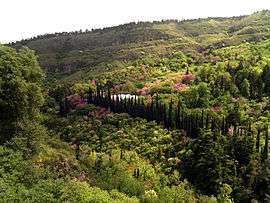
Location
Tbilisi is located in the South Caucasus at 41° 43' North Latitude and 44° 47' East Longitude. The city lies in Eastern Georgia on both banks of the Mt'k'vari River. The elevation of the city ranges from 380–770 metres above sea level (1,250–2,530 ft) and has the shape of an amphitheatre surrounded by mountains on three sides. To the north, Tbilisi is bounded by the Saguramo Range, to the east and south-east by the Iori Plain, to the south and west by various endings (sub-ranges) of the Trialeti Range.
The relief of Tbilisi is complex. The part of the city which lies on the left bank of the Mt'k'vari River extends for more than 30 km (19 mi) from the Avchala District to River Lochini. The part of the city which lies on the right side of the Mt'k'vari River, on the other hand, is built along the foothills of the Trialeti Range, the slopes of which in many cases descend all the way to the edges of the river Mt'k'vari. The mountains, therefore, are a significant barrier to urban development on the right bank of the Mt'k'vari River. This type of a geographic environment creates pockets of very densely developed areas while other parts of the city are left undeveloped due to the complex topographic relief.
To the north of the city, there is a large reservoir (commonly known as the Tbilisi Sea) fed by irrigation canals.
Climate
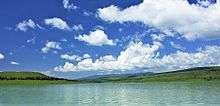
Tbilisi has a humid subtropical climate (Köppen climate classification: Cfa) with considerable continental and semi-arid influences. The city experiences very warm summers and moderately cold winters. Like other regions of Georgia, Tbilisi receives significant rainfall throughout the year with no distinct dry period. The city's climate is influenced both by dry (Central Asian/Siberian) air masses from the east and oceanic (Atlantic/Black Sea) air masses from the west. Because the city is bounded on most sides by mountain ranges, the close proximity to large bodies of water (Black and Caspian Seas) and the fact that the Greater Caucasus Mountains Range (further to the north) blocks the intrusion of cold air masses from Russia, Tbilisi has a relatively mild microclimate compared to other cities that possess a similar climate along the same latitudes.
The average annual temperature in Tbilisi is 13.3 °C (55.9 °F). January is the coldest month with an average temperature of 2.3 °C (36.1 °F). July is the hottest month with an average temperature of 24.9 °C (76.8 °F). Daytime high temperatures reach or exceed 32 °C (90 °F) on an average of 22 days during a typical year. The absolute minimum recorded temperature is −24.4 °C (−11.9 °F) in January 1883 and the absolute maximum is 42.0 °C (107.6 °F) on 17 July 1882.[39] Average annual precipitation is 495.5 mm (19.5 in). May is the wettest month (averaging 77.6 mm (3.1 in) of precipitation) while January is the driest (averaging 18.9 mm (0.7 in) of precipitation). Snow falls on average 15–25 days per year. The surrounding mountains often trap the clouds within and around the city, mainly during the Spring and Autumn months, resulting in prolonged rainy and/or cloudy weather. Northwesterly winds dominate in most parts of Tbilisi throughout the year. Southeasterly winds are common as well.
| Climate data for Tbilisi | |||||||||||||
|---|---|---|---|---|---|---|---|---|---|---|---|---|---|
| Month | Jan | Feb | Mar | Apr | May | Jun | Jul | Aug | Sep | Oct | Nov | Dec | Year |
| Record high °C (°F) | 19.5 (67.1) |
22.4 (72.3) |
28.9 (84.0) |
34.4 (93.9) |
35.1 (95.2) |
40.2 (104.4) |
42.0 (107.6) |
40.4 (104.7) |
37.9 (100.2) |
33.3 (91.9) |
27.2 (81.0) |
22.8 (73.0) |
42.0 (107.6) |
| Average high °C (°F) | 6.6 (43.9) |
7.7 (45.9) |
12.6 (54.7) |
18.9 (66.0) |
23.1 (73.6) |
28.1 (82.6) |
31.2 (88.2) |
30.9 (87.6) |
26.4 (79.5) |
19.8 (67.6) |
12.8 (55.0) |
8.4 (47.1) |
18.9 (66.0) |
| Daily mean °C (°F) | 2.3 (36.1) |
3.1 (37.6) |
7.2 (45.0) |
12.7 (54.9) |
17.2 (63.0) |
21.7 (71.1) |
24.9 (76.8) |
24.7 (76.5) |
20.2 (68.4) |
14.2 (57.6) |
7.9 (46.2) |
3.7 (38.7) |
13.3 (55.9) |
| Average low °C (°F) | −0.8 (30.6) |
0.0 (32.0) |
3.2 (37.8) |
8.4 (47.1) |
12.4 (54.3) |
16.5 (61.7) |
19.8 (67.6) |
19.5 (67.1) |
15.4 (59.7) |
10.4 (50.7) |
4.9 (40.8) |
1.3 (34.3) |
9.3 (48.7) |
| Record low °C (°F) | −24.4 (−11.9) |
−14.8 (5.4) |
−12.8 (9.0) |
−3.8 (25.2) |
1.0 (33.8) |
6.3 (43.3) |
9.3 (48.7) |
8.9 (48.0) |
0.8 (33.4) |
−6.4 (20.5) |
−7.1 (19.2) |
−20.5 (−4.9) |
−24.4 (−11.9) |
| Average precipitation mm (inches) | 18.9 (0.74) |
25.8 (1.02) |
30.3 (1.19) |
50.5 (1.99) |
77.6 (3.06) |
76.0 (2.99) |
44.9 (1.77) |
47.5 (1.87) |
35.6 (1.40) |
37.5 (1.48) |
29.9 (1.18) |
21.0 (0.83) |
495.5 (19.51) |
| Average precipitation days | 4.0 | 4.6 | 5.9 | 7.6 | 9.7 | 8.7 | 5.7 | 5.7 | 5.0 | 5.6 | 4.4 | 4.0 | 70.9 |
| Average relative humidity (%) | 74 | 72 | 68 | 66 | 67 | 64 | 61 | 62 | 66 | 73 | 76 | 76 | 69 |
| Mean monthly sunshine hours | 99 | 102 | 142 | 171 | 213 | 249 | 256 | 248 | 206 | 164 | 103 | 93 | 2,046 |
| Source: Pogoda.ru.net (Temperatures, humidity),[39]
WMO (Precipitation, precipitation days),[40] NOAA (Sunshine hours)[41] | |||||||||||||
Demographics
Population
| 1801-3[25] | 4,300 | 21.5% | 14,860 | 74.3% | 20,000 | ||||||||||||
|---|---|---|---|---|---|---|---|---|---|---|---|---|---|---|---|---|---|
| 1864/65 winter[42] | 14,878 | 24.8% | 28,404 | 47.3% | 12,462 | 20.7% | 60,085 | ||||||||||
| 1864/65 summer[42] | 14,787 | 20.8% | 31,180 | 43.9% | 12,142 | 17.1% | 71,051 | ||||||||||
| 1876[43] | 22,156 | 21.3% | 37,610 | 36.1% | 30,813 | 29.6% | 104,024 | ||||||||||
| 1897[44] | 41,151 | 29.5% | 47,133 | 36.4% | 44,823 | 28.1% | 159,590 | ||||||||||
| 1926[26] | 112,014 | 38.1% | 100,148 | 34.1% | 45,937 | 15.6% | 294,044 | ||||||||||
| 1939[26] | 228,394 | 44% | 137,331 | 26.4% | 93,337 | 18% | 519,220 | ||||||||||
| 1959[26] | 336,257 | 48.4% | 149,258 | 21.5% | 125,674 | 18.1% | 694,664 | ||||||||||
| 1970[26] | 511,379 | 57.5% | 150,205 | 16.9% | 124,316 | 14% | 889,020 | ||||||||||
| 1979[26] | 653,242 | 62.1% | 152,767 | 14.5% | 129,122 | 12.3% | 1,052,734 | ||||||||||
| 2002[45] | 910,712 | 84.2% | 82,586 | 7.6% | 32,580 | 3% | 1,081,679 | ||||||||||
| 2014[46] | 996,804 | 89.9% | 53,409 | 4.8% | 13,350 | 1.2% | 1,108,717 | ||||||||||
As a multicultural city, Tbilisi is home to more than 100 ethnic groups. Around 89% of the population consists of ethnic Georgians, with significant populations of other ethnic groups such as Armenians, Russians, and Azerbaijanis. Along with the above-mentioned groups, Tbilisi is home to other ethnic groups including Ossetians, Abkhazians, Ukrainians, Greeks, Germans, Jews, Estonians, Kurds, Assyrians & Yazidis, and others.[25][26][42][43][47]
Religion
More than 95% of the residents of Tbilisi practise some form of Christianity (the most predominant of which is the Georgian Orthodox Church). The Russian Orthodox Church, which is in Full communion with the Georgian Orthodox Church, and the Armenian Apostolic Church have significant followings as well. A minority of the population (around 1.5%) practises Islam (mainly Shia Islam), while about 0.1% of Tbilisi's population practises Judaism.[48] There is also a Roman Catholic church and the Yazidi Sultan Ezid Temple.[49][50]
Sports
Up until the beginning of the 19th century, sports such as horse-riding (polo in particular), wrestling, boxing, and marksmanship were the most popular city sports. Influence from the Russian Empire brought more Western sports and activities (billiards, fencing) to Tbilisi.
The Soviet period brought an increased popularization of sports that were common in Europe and to a certain extent, the United States. At the same time, Tbilisi developed the necessary sports infrastructure for professional sports. By 1978, the city had around 250 large and small sports facilities, including among others, four indoor and six outdoor Olympic sized pools, 185 basketball courts and halls, 192 volleyball facilities, 82 handball arenas, 19 tennis courts, 31 football fields, and five stadiums. The largest stadium in Tbilisi is the Dinamo Arena (55,000 seats) and the second largest is the Mikheil Meskhi Stadium (24,680 seats). The Sports Palace which usually hosts basketball games with high attendance and tennis tournaments can seat approximately 11,000 people.
Vere Basketball Hall is a smaller indoor sports arena with a 2,500 seating capacity.
The most popular sports in Tbilisi today are football, rugby union, basketball, and wrestling. Also, popular sports include tennis, swimming and water polo. There are several professional football and rugby teams as well as wrestling clubs. U.S. National Basketball Association players Zaza Pachulia and Nikoloz Tskitishvili are Tbilisi natives. Outside of professional sports, the city has a number of intercollegiate and amateur sports teams and clubs.
Tbilisi's signature football team, Dinamo Tbilisi, has not won a major European championship since the 1980–1981 season, when it won the European UEFA Cup Winners' Cup and became the easternmost team in Europe to achieve the feat. The basketball club Dinamo Tbilisi won the Euroleague in 1962 but also never repeated any such feat.
Tbilisi will host several Group Phase matches for the EuroBasket 2021 in the country, Czech Republic (Prague), Germany (Berlin, Cologne) and Italy (Milan).

| Club | Sport | Stadium |
|---|---|---|
| Lelo Saracens | Rugby Union | Lelo Sport Centre |
| RC Armazi Tbilisi | Rugby Union | Shevardeni Stadium |
| RC Locomotive Tbilisi | Rugby Union | Avchala Stadium |
| RC Army Tbilisi | Rugby Union | Avchala Stadium |
| FC Dinamo Tbilisi | Football | Boris Paichadze Stadium |
| FC Lokomotivi Tbilisi | Football | Mikheil Meskhi Stadium |
| FC Saburtalo Tbilisi | Football | Bendela Stadium |
| FC WIT Georgia | Football | Mikheil Meskhi Stadium #2 |
| BC Dinamo Tbilisi | Basketball | Tbilisi Sports Palace |
| BC TSU Tbilisi | Basketball | Tbilisi Sports Palace |
| BC MIA Academy | Basketball | Tbilisi Sports Palace |
| BC Armia | Basketball | Tbilisi Sports Palace |
| Maccabi Brinkford Tbilisi | Basketball | Tbilisi Sports Palace |
| B.C. VITA Tbilisi | Basketball | Tbilisi Sports Palace |
Media
The large majority of Georgia's media companies (including television, newspaper, and radio) are headquartered in Tbilisi. The city is home to the popular Rustavi 2 television channel which gained considerable fame after its coverage of the Rose Revolution. In addition to Rustavi 2, the remaining three out of the four major public television channels of Georgia (including Imedi TV Maestro and the Public Broadcasting Channel) are based in the city. Tbilisi's television market has experienced notable changes since the second half of 2005 when Rustavi 2 successfully bought out the Mze TV company and Rupert Murdoch's News Corporation became a shareholder of Imedi Media Holding at the beginning of 2006.
Tbilisi has a number of newspaper publishing houses. Some of the most noteworthy newspapers include the daily 24 Saati ("24 Hours"), Rezonansi ("Resonance"), Alia, the English-language daily The Messenger, weekly FINANCIAL, Georgia Today, and the English-language weekly The Georgian Times. Out of the city's radio stations Imedi Radio (105.9 FM), Fortuna, and Radio 105 are some of the most influential competitors with large national audiences.
Radio stations in Tbilisi include 5 Lines Radio (93.8 FM), Europe +Tbilisi (99.6 FM), and Georgian Patriarchy Radio (105.4 FM).[51]
Culture
Architecture
%2C_built_19th_century_in_Rococo_style.jpg)
The architecture in the city is a mixture of local (Georgian) and Byzantine, Neoclassical, Art Nouveau, Beaux-Arts, Middle Eastern, and Soviet modern styles.[52] Very few buildings survived the destruction of the city in 1795, so most historical buildings in Tbilisi date to the Russian Imperial period (1801–1917). The oldest parts of the city (Kala, Abanotubani, Avlabari) were largely rebuilt on their medieval street plans, and some old houses were even rebuilt on much older foundations. The areas of downtown Tbilisi which were developed according to a European-style plan by Russian authorities (Sololaki, Rustaveli Avenue, Vera, etc.) have a Western appearance, with a mix of styles popular in Europe at the time: Beaux Arts, Orientalist, and various period revival styles.
Tbilisi is most notable for its abundance of Art Nouveau buildings and details (common in Sololaki and Chughureti), which flourished from the mid-1890s to through the end of Russian rule. Art Nouveau was decreed as bourgeois by communist authorities, who introduced experimental modern architecture. The more conservative and historically-inflected Stalinist architecture in Georgia is embodied by the 1938 Marx-Engels-Lenin Institute building ("Imeli"), now housing the Biltmore Hotel Tbilisi.
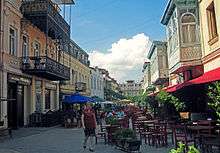
Tbilisi's postwar architecture is similar to the brand of midcentury modernism found across the Soviet Union. The city expanded dramatically in response to a housing crisis after World War II. Entire neighborhoods (Saburtalo, Dighomi) appeared on the outskirts of the city in a matter of decades, built with advances in mass-production technology. Georgian architects produced some of the Soviet Union's most interesting architectural achievements, including Tbilisi's 1975 Ministry of Roads and the 1984 Wedding Palace. Since the collapse of the Soviet Union, the urban landscape is largely characterized by unregulated construction. New towers occupy formerly public spaces and overcrowded apartment buildings sprout "kamikaze loggia" overnight. Since 2004, the city government has taken initiatives to curb uncontrolled construction projects with mixed success. Soon Tbilisi will have three skyscraper complexes. The Axis Towers, Redix Chavchavadze 64, and the new Ajara Hotel/Business Complex, which is currently under construction, will be the tallest buildings/skyscrapers in the Caucasus.
Theatre, dance and music
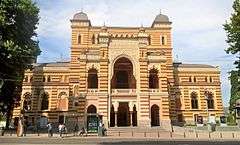
The city has important theatre and music institutions, such as the Tbilisi State Conservatoire, the Tbilisi Opera and Ballet Theatre, the Shota Rustaveli State Academic Theatre, and the Marjanishvili State Academic Theatre.
Arts museums and galleries
The Georgian National Museum gathers several important museums, including the Art Museum of Georgia. The Museum of Modern Art was founded in 2012.[53] Two independent contemporary art organisations, Kunsthalle Tbilisi[54] and Open Space of Experimental Art,[55] were founded in 2018.
Tourism
Main sights
Tbilisi has important landmarks and sightseeing locations. The Parliament and the government (State Chancellery) buildings of Georgia, the Supreme Court of Georgia, the Sameba Cathedral, the Vorontsov's Palace (also known as the Children's Palace today), the National Public Library of the Parliament of Georgia, the National Bank of Georgia, Tbilisi Circus, The Bridge of Peace, and many state museums are in Tbilisi. During the Soviet times, Tbilisi continuously ranked in the top four cities in the Soviet Union for the number of museums.
Out of the city's historic landmarks, the most notable are the Narikala fortress (4th–17th century), Anchiskhati Basilica (6th century, built up in the 16th century), Sioni Cathedral (8th century, later rebuilt), and Church of Metekhi, Open Air Museum of Ethnography, Sulfur Bath, and Tbilisi Old City.
Nightlife
Beyond traditional attractions, Tbilisi has developed burgeoning nightclub culture which started to attract international media attention in the 2010s. The leading clubs such as Bassiani, Mtkvarze, Khidi, and Café Gallery have featured major international DJs as well as local performers.[56][57]
Economy
With a GDP at basic prices of 12,147 million Georgian lari (€4.3 billion) in 2014, Tbilisi is the economic center of the country, generating almost 50 percent of Georgia's GDP. The service sector, including government services, is dominating and contributes 88 percent to GDP. Its GDP per capita of 10,336 Georgian lari (€3,600) is exceeding the national average by more than 50 percent. The service sector itself is dominated by the wholesale and retail trade sector, reflecting the role of Tbilisi as transit and logistics hub for the country and the South Caucasus. The manufacturing sector contributes only 12 percent to Tbilisi's GDP, but is much larger, by employment and total value added, than the manufacturing sectors in any other region of Georgia. The unemployment rate in Tbilisi is – with 22.5 percent – significantly higher in Tbilisi than in the regions.[58]
Transportation
Airport
Shota Rustaveli Tbilisi International Airport is Tbilisi's only international airport, located about 18 kilometres (11 miles) southeast of the city center. Handling 3.16 million passengers in 2017, it is the busiest airport in Georgia and the seventeenth busiest airport in the former Soviet Union. The airport has been rapidly growing over the past decade, handling more than 3.56 million passengers in 11 months of 2018.[59] It is a hub for the National carrier Georgian Airways and a Georgian-Chinese start-up Myway Airlines. As of December 2018, various airlines serve routes to major European and Asian hubs, such as: London, Munich, Berlin, Amsterdam, Dubai, Brussels, Vienna, Paris, Doha etc. Tbilisi International Airport in 2016 started to utilize solar energy and became the first "green airport" in the Caucasus region in 2008.
Natakhtari Airfield, located 33 km north of Tbilisi in the town of Natakhtari, is a domestic airport serving the capital on routes to Batumi, Mestia and Ambrolauri.
Metro

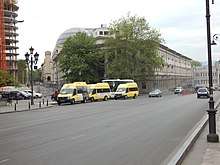
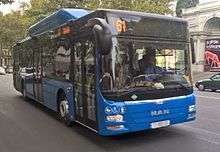
The Tbilisi Metro serves the city with rapid transit subway services. It was the Soviet Union's fourth metro system. Construction began in 1952 and was finished in 1966. The system operates two lines, the Akhmeteli-Varketili Line and the Saburtalo Line. It has 23 stations and 186 metro cars. Most stations, characteristic to Soviet-built metro systems, are extravagantly decorated. Trains run from 6:00 am to midnight. Due to the uneven ground, the rail lines run above ground in some areas. Two of the stations are above ground.
The third overground line is planned to connect central Tbilisi with suburbs and Tbilisi International Airport with a possible extension to Rustavi, 30 km east of Tbilisi.[60]
Tram
Tbilisi had a tram network, since 1883 starting from horse-driven trams and from 25 December 1904 electric tramway. When the Soviet Union disintegrated, electric transport went to a degradation state within the years and finally the only tram line left was closed on 4 December 2006 together with two trolleybus lines which were left.[61][62] There are plans to construct a modern tram network.[63][64]
Minibus
The most dominant form of transportation is the minibus. An elaborate minibus system has grown in Tbilisi over the recent years. In addition to the city, several lines also serve the surrounding countryside of Tbilisi. Throughout the city, a fixed price is paid regardless of the distance (80 or 50 tetri in 2018). For longer trips outside the city, higher fares are common. As of April 2018, there are no predefined stops for the minibus lines, except 14 streets,[65] they are hailed from the streets like taxis and each passenger can exit whenever he likes.
Municipal bus
The second largest form of transportation are the municipal buses which are operated by Tbilisi Transport Company. As of October 2018, 672 buses of various size are servicing the city, majority of them are Ukrainian Bogdan A144 and A092 models along with 143 energy-efficient MAN Lion's City buses.[66] New MAN Lion's City buses were put in service in 2017. Later in 2018, the tender was announced to order 90 new buses. Tegeta trucks&Buses won the tender and will be delivering aforementioned order in early 2019.[67] In October 2018, at the Georgian Dream conference, it was announced that all the buses will be changed with new ones by the end of 2019, out of which 90 will be electric. Moreover, Kaladze asserted, that by 2020, Tbilisi will have 200 electric buses and the total number will reach 900.[68]
Aerial tramways
Historically, the city had seven different aerial tramways, but all of them closed after the collapse of the Soviet Union.
Since 2012, Tbilisi has a modern, high-capacity gondola lift which operates between Rike Park and the Narikala fortress; each gondola can carry up to 8 persons. The system was built by the Italian manufacturer Leitner Ropeways.[69]
Since October 12, 2016, Turtle Lake aerial tramway (originally opened in 1965) reopened after seven years out of service. It underwent major reconstruction but kept the old designs of gondolas and stations. This tramway connects Vake Park with Turtle Lake.
Since October 2016, another Soviet-era aerial tramway between State University (Maglivi) and University Campus (Bagebi) in Saburtalo District (originally opened in 1982) is being reconstructed after 13 years of abandonment and is due for opening in April 2018. The original Italian-produced cabins produced by Lovisolo and provided by Ceretti & Tanfani, with a capacity of 40 passengers each, are being kept as well as the stations.
Due to mismanagement at the hands of Soviet authorities, one of the main aerial trams experienced a major malfunction, causing the 1990 Tbilisi aerial tramway accident and remaining closed ever since.[70] Since October 2017, the aerial tram has been under reconstruction, keeping the old culturally significant lower station but with plans for new gondolas, masts, upper station and other infrastructure. The project is carried out by Doppelmayr Garaventa Group.
Funicular
Tbilisi funicular reopened 2012 after a multi-year closure. It is a ropeway railway first built 1905, connecting Chonkadze street and Mtatsminda Park, and covering almost 300 m (980 ft) in altitude difference. The top of the hill is the highest point of the city, offering many different views of Tbilisi, and is home to the Tbilisi TV Broadcasting Tower as well as some amusement rides, including a roller-coaster and a ferris wheel.
The half-way station of the funicular is just a short way away from Mtatsminda Pantheon, providing easy access to the necropolis.
Education

Tbilisi is home to several major institutions of higher education including the Tbilisi State Medical University and the Petre Shotadze Tbilisi Medical Academy, famous for their internationally recognised medical education system. The biggest Georgian university is Tbilisi State University which was established on 8 February 1918. TSU is the oldest university in the whole Caucasus region. Over 35,000 students are enrolled and the number of faculty and staff (collaborators) is approximately 5,000. Tbilisi is also home to the largest medical university in Caucasus region – Tbilisi State Medical University, which was founded as Tbilisi Medical Institute in 1918 and became the Faculty of Medicine within the Tbilisi State University (TSU) in 1930. Tbilisi State Medical Institute was renamed to Medical University in 1992. Since that university operates as an independent educational institution, TSMU became one of the high-ranking state-supported institutions of higher education in the Caucasus region. There are almost 5000 undergraduate and 203 postgraduate students at the university of whom 10% come from foreign countries.
Georgia's main and largest technical university, Georgian Technical University, is in Tbilisi. Georgian Technical University was founded in 1922 as a polytechnic faculty of the Tbilisi State University. The first lecture was read by the world-famous Georgian mathematician Professor Andria Razmadze. It achieved University status by 1990. The three most popular private higher educational institution in Georgia —The University of Georgia (Tbilisi), Caucasus University, and the Free University of Tbilisi – are in Tbilisi.
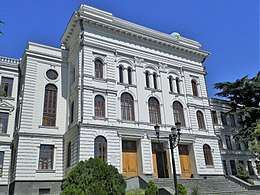
The University of Georgia (Tbilisi) is the largest private University in Georgia, with more than 3500 international and local students. It was established in 2005 and soon became a market leader within Georgian educational sector. In 2010, the UG received financing from OPIC (Overseas Private Investment Corporation) for a development of the University's infrastructure and technical equipment. The University of Georgia has various undergraduate and graduate programs and it's the first company in Georgia which offers international certificate programs of the Oracle Corporation, Microsoft, Zend technologies and Cisco Academy.
Caucasus University was established in 2004 as an expansion of the Caucasus School of Business (CSB) (established in 1998) by a consortium consisting of Tbilisi State University and Georgian Technical University in partnership with Georgia State University (Atlanta, USA). The Free University of Tbilisi was established in 2007 through the merger of two higher education schools: European School of Management (ESM-Tbilisi) and Tbilisi Institute of Asia and Africa (TIAA). Today Free University comprises three schools — Business School (ESM), Institute of Asia and Africa and Law School — delivering academic programs at the undergraduate, graduate and doctorate levels. In addition, Free University conducts a wide array of short-term courses and runs several research centers and summer school programs.
Higher educational institutions in Tbilisi:
- Tbilisi State University
- Ilia State University
- Georgian Technical University
- Tbilisi State Conservatory
- Shota Rustaveli Theatre and Film University
- Tbilisi State Academy of Arts
- The University of Georgia (Tbilisi)
- Tbilisi State Medical University
- Caucasus University
- Caucasus International University
- Tbilisi Medical Academy
- Free University of Tbilisi
- Grigol Robakidze University – Alma Mater
- Georgian American University
- International Black Sea University
- Georgian Institute of Public Affairs
- Agricultural University of Georgia
- International School of Economics (ISET)
- The University of Geomedi
- New Vision University[71]
Living in Tbilisi
Tbilisi is home to many foreigners. The number of foreigners living and working in Tbilisi has risen in recent years together with the openings of international schools, businesses, expat's communities, and online networks. Tbilisi is a very safe city. Most of the expatriates are living in Vake, Vera, Saburtalo, and Dighomi. A lot of expatriate communities could be found in Tbilisi. Some of them are charging a membership fee.
- IWA, International Women Association is a non profit organisation founded in 1996 and its members and participants are International and Georgian women.
- Expats in Tbilisi is an Online Support Network founded by UN and EU Staff Spouses in Georgia Country to support expatriates in finding information and all relevant resources in one place.
- Inter-nation International[72]
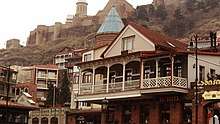
International relations
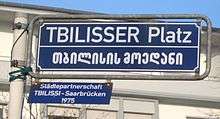
Twin towns and sister cities
|
|
Partnerships
See also
- Abo Tbileli, the patron saint of Tbilisi
- Baku-Tbilisi-Ceyhan pipeline
- List of Tbilisians
References
- კონსპექტი საქართველოს ისტორიიდან შედგენილი ა. ქუთათელაძისგან. რვეული I. თბილისი, სტამბა წიგნების გამომცემელ ქართველთა ამხანაგობისა, 1900. გვერდი 38.
- "Mayor of Tbilisi". Tbilisi City Hall. Retrieved 20 November 2017.
- "Statistics of Tbilisi Region". National Statistics Office of Georgia. Retrieved 22 July 2018.
- "Population by regions". NATIONAL STATISTICS OFFICE OF GEORGIA. Retrieved 15 January 2019.
- https://www.geostat.ge/regions/
- https://globaldatalab.org/shdi/shdi/GEO/?interpolation=0&extrapolation=0&nearest_real=0&years=2018
- Jones, Daniel (2011). Roach, Peter; Setter, Jane; Esling, John (eds.). Cambridge English Pronouncing Dictionary (18th ed.). Cambridge University Press. ISBN 978-0-521-15255-6.
- Tbilisi is known by its former name Tiflis in a number of languages, notably in Persian, German, Turkish and others. Pre-1936 Russian sources use "Tiflis" as well.
- „როცა ტფილისი გახდა თბილისი." [When Tiflis became Tbilisi] (in Georgian). Radio Tavisupleba. 17 February 2005. Retrieved 1 May 2018.
- "ArticleEngl". geoarchencyclopedia.ge. Retrieved 16 April 2019.
- cguardia (3 February 2016). "The Scythians in Tbilisi: Recent Excavations at Treligorebi". Institute for the Study of the Ancient World. Retrieved 16 April 2019.
- Rayfield, Donald, 1942- author. (11 February 2019). Edge of empires : a history of Georgia. ISBN 978-1-78914-059-0. OCLC 1053903394.CS1 maint: multiple names: authors list (link)
- "The Golden Age of Georgia". Dictionary of Georgian National Biography. Retrieved 2 February 2008.
- "Country Overview". Invest in Georgia. Archived from the original on 1 January 2008. Retrieved 2 February 2008.
This early Georgian renaissance ... preceded its European analogue by several hundred years
- Rayfield 2013, pp. 164, 166.
- Hitchins 2001, pp. 464–470.
- Rayfield 2013, p. 166.
- Floor 2008, pp. 295–296.
- Kazemzadeh 1991, pp. 328–330.
- Suny, pp. 58–59
- "Relations between Tehran and Moscow, 1797–2014". Retrieved 15 December 2014.
- Timothy C. Dowling Russia at War: From the Mongol Conquest to Afghanistan, Chechnya, and Beyond pp 728–729 ABC-CLIO, 2 dec. 2014. ISBN 978-1598849486
- Mikaberidze, Alexander. Conflict and Conquest in the Islamic World: A Historical Encyclopedia 2 volumes: A Historical Encyclopedia ABC-CLIO, 22 jul. 2011 ISBN 978-1598843378 p 351
- Kazemzadeh, Firuz (2013). Russia and Britain in Persia: Imperial Ambitions in Qajar Iran. I.B.Tauris. p. 5. ISBN 978-0857721730.
- Ronald Grigor Suny (1994). The making of the Georgian nation. Indiana University Press. pp. 116–. ISBN 978-0-253-20915-3. Retrieved 16 November 2011.
- (in Russian) Ethno-Caucasus, население Кавказа, республика Грузия, население Грузии
- Marshall, David (1962). History of Modern Georgia. p. 211.
- Jones, Stephen F. (2005). Socialism in Georgian Colors. London.
- Marshall, David (1962). History of Modern Georgia.
- Бабенко, Виталий (October 1983). ...внутри драгоценного круга. Vokrug Sveta (in Russian). 1983 (10 (2517)). Retrieved 19 August 2012.
- Rukhadze, Vasili; Tobias Moerschen (2007). "Analysis of Tbilisi's Real Estate Boom" (PDF). Retrieved 22 November 2009.
- "Rustavi 2". Rustavi 2. Retrieved 3 June 2011.
- Sergey Gevenov. "Tbilisi railway project to start : Story by Nino Edilashvili : Georgia Today on the Web". Georgiatoday.ge. Archived from the original on 21 July 2011. Retrieved 3 June 2011.
- "Issue 1, 2010 – Tbilisi 2010". Investor.ge. Archived from the original on 7 October 2011. Retrieved 3 June 2011.
- "Georgia flood: Tbilisi residents warned over zoo animals after devastating flood". BBC News. 14 June 2015. Retrieved 15 June 2015.
- (in Georgian) საქართველოს დედაქალაქის – თბილისის შესახებ. The Parliament of Georgia. Retrieved 22 May 2007.
- Karl Baedeker, Russia: A Handbook for Travelers (Arno Press, 1971, reprint of 1914 ed.), p. 467.
- JSC IBERIA Realty Architectural Competition.
- Погода и Климат (in Russian). Pogodaiklimat.ru. Retrieved 19 October 2016.
- "World Weather Information Service – Tbilisi". World Meteorological Organization. Retrieved 19 October 2016.
- "Tbilisi/Novoalexeye Climate Normals 1961–1990". National Oceanic and Atmospheric Administration. Retrieved 19 October 2016.
- (in Russian) Тифлис // Географическо-статистический словарь Российской империи.St. Petersburg, 1885, p. 133 (Note: this is a 'one-day census' of unknown scope and methodology).
- Ronald Grigor Suny (1994). The making of the Georgian nation. Indiana University Press. p. 368. ISBN 978-0-253-20915-3. Retrieved 29 December 2011. (one-day census of Tiflis)
- (in Russian) Первая всеобщая перепись населения Российской Империи 1897 г.. Изд. Центр. стат. комитета МВД: Тифлисская губерния. – St. Petersburg, 1905, pp. 74—75.(Note: The census did not contain a question on ethnicity, which was deduced from data on mother tongue, social estate and occupation)
- "Ethnic groups by major administrative-territorial units" (PDF). 14 November 2009. Archived from the original (PDF) on 14 November 2009. Retrieved 19 December 2012.
- "Population Census 2014". www.geostat.ge. National Statistics Office of Georgia. November 2014. Retrieved 2 June 2016.
- "Ethnic groups by major administrative-territorial units" (PDF). 14 November 2009. Archived from the original (PDF) on 14 November 2009. Retrieved 19 December 2012.
- "GeoStat.Ge". www.geostat.ge. Retrieved 31 January 2017.
- "Saint Peter and Paul Catholic Church". www.georgianholidays.com. Retrieved 31 January 2017.
- "Yezidis of Georgia celebrate new temple in Tbilisi". Rudaw. Retrieved 31 January 2017.
- Tbilisi Municipal Portal – Radio Archived 17 December 2013 at the Wayback Machine
- Suny, Ronald Grigor (1996). Curtis, Glen E. (ed.). Armenia, Azerbaijan, and Georgia. DIANE Publishing. p. 184. ISBN 978-0788128134.
(...) Persian occupation added a new element, and in the nineteenth century Russian domination created a hybrid architectural style visible in many buildings in Tbilisi. The so-called Stalinist architecture of the mid-twentieth century also left its mark on the capital."
- Rabimov, Stephan. "The Tbilisi Art Scene Looks Inside Georgia". Forbes. Retrieved 19 July 2020.
- "Kunsthalle Tbilisi: new art space opening with contemporary exhibitions". Agenda.ge. Retrieved 19 July 2020.
- "Open Space: new experimental art platform launches in Tbilisi". Agenda.ge. Retrieved 19 July 2020.
- House, Arthur (21 September 2016). "Clubbers, forget London and Berlin – the place to dance is eastern Europe". The Guardian. Retrieved 11 February 2017.
- Lynch, Will (15 August 2016). "Tbilisi and the politics of raving". Resident Advisor. Retrieved 11 February 2017.
- "Regional Statistics". Geostat. Retrieved 6 April 2016.
- "Passenger Traffic up by 23% at Georgian Airports". Georgian today. Retrieved 10 December 2018.
- "New metro stations to link center and outskirts of Tbilisi". Vestnik Kavkaza. 22 October 2018. Retrieved 15 January 2019.
- "Subways and Trams in Georgia: Tbilisi". 24 December 2010. Retrieved 24 December 2010.
- "georgiandaily.com – Nostalgic Tbilisi residents want their tramway back". 24 December 2010. Retrieved 24 December 2010.
-
- "Railway Gazette: Tbilisi tram design contract signed". 24 December 2010. Retrieved 24 December 2010.
- "Trams to return? : by Salome Kobalava : Georgia Today on the Web". 24 December 2010. Archived from the original on 19 January 2011. Retrieved 24 December 2010.
- "თბილისის ქუჩები, სადაც სამარშრუტო ტაქსები მხოლოდ გაჩერების ადგილებზე გაჩერდებიან". commersant.ge (in Georgian). 28 December 2017. Retrieved 7 April 2018.
- "Tbilisi buys 143 new longer, gas-powered buses". 13 July 2016. Retrieved 23 October 2018.
- "Tbilisi City Hall to Convey 90 New Buses". 8 August 2018. Retrieved 17 October 2016.
- "Gov't launches 'Green Policy – Eco-friendly Transport' project: What's in store for Tbilisi?". 22 October 2018. Retrieved 23 October 2018.
- "Tbilisi Ropeway".
- "Major worldwide cable car accidents since 1976". CNN. Retrieved 19 December 2012.
- "Contact". Retrieved 30 May 2017.
- "Tbilisi Sister Cities". Tbilisi City Hall. Tbilisi Municipal Portal. Archived from the original on 24 July 2013. Retrieved 5 August 2013.
- "Medmestno in mednarodno sodelovanje". Mestna občina Ljubljana (Ljubljana City) (in Slovenian). Archived from the original on 26 June 2013. Retrieved 27 July 2013.
- "Bristol City – Town twinning". Bristol City Council. Archived from the original on 28 July 2011. Retrieved 17 July 2009.
- "Yerevan – Twin Towns & Sister Cities". Yerevan Municipality Official Website. Yerevan Municipality. Retrieved 4 November 2013.
- ԵՐԵՎԱՆԻ ՔԱՂԱՔԱՊԵՏԱՐԱՆՊԱՇՏՈՆԱԿԱՆ ԿԱՅՔ [Yerevan expanding its international relations] (in Armenian). Yerevan Municipality. Archived from the original on 12 May 2013. Retrieved 5 August 2013.
- "Oraşe înfrăţite (Twin cities of Minsk) [via WaybackMachine.com]" (in Romanian). Primăria Municipiului Chişinău. Archived from the original on 3 September 2012. Retrieved 21 July 2013.
- "Legal Framework". Embassy of Georgia to the State of Qatar. Retrieved 7 July 2018.
- "Arak Tourist Attractions And Info – Iran Travel Guide – Trip Yar". en.tripyar.com. Retrieved 15 October 2018.
- "ToIran, Tourism Platform in Iran". www.toiran.com. Retrieved 15 October 2018.
- Behnegarsoft.com. قفقاز – اراک و تفليس خواهرخوانده ميشوند. www.ccsi.ir. Retrieved 15 October 2018.
- "Tbilisi-Tehran direct flights will start next month". Agenda.ge. Retrieved 20 May 2015.
- "თბილისსა და სტამბოლს შორის დაძმობილების შესახებ მემორანდუმი გაფორმდა". Tbilisi City Hall. Retrieved 19 April 2016.
- "Kraków – Miasta Partnerskie" [Kraków -Partnership Cities]. Miejska Platforma Internetowa Magiczny Kraków (in Polish). Archived from the original on 2 July 2013. Retrieved 10 August 2013.
- "Partnerská města HMP" [Prague – Twin Cities HMP]. Portál "Zahraniční vztahy" [Portal "Foreign Affairs"] (in Czech). 18 July 2013. Archived from the original on 25 June 2013. Retrieved 5 August 2013.
Bibliography
- Abuladze, David; Kurtishvili, Irina (March 2016). Stiller, Adolph (ed.). Tiflis: Architektur am Schnittpunkt der Kontinente (in English and German). Salzburg: Muery Salzmann. ISBN 978-3990141366.CS1 maint: ref=harv (link)
- Baulig, Josef; Maia Mania; Hans Mildenberg; Karl Ziegler (2004). Architekturführer Tbilisi (in German and Georgian). Landeshauptstadt Saarbrücken/Technische Universität Kaiserslautern. ISBN 978-3-936890-39-6.CS1 maint: ref=harv (link)
- Floor, Willem M. (2008). Titles and Emoluments in Safavid Iran: A Third Manual of Safavid Administration, by Mirza Naqi Nasiri. Washington, DC: Mage Publishers. pp. 1–324. ISBN 978-1933823232.CS1 maint: ref=harv (link)
- Hitchins, Keith (2001). "GEORGIA ii. History of Iranian-Georgian Relations". Encyclopaedia Iranica, Vol. X, Fasc. 4. pp. 464–470.CS1 maint: ref=harv (link)
- Kazemzadeh, Firuz (1991). "Iranian relations with Russia and the Soviet Union, to 1921". In Peter, Avery; Hambly, Gavin; Melville, Charles (eds.). The Cambridge History of Iran (Vol. 7). Cambridge University Press. ISBN 978-0521200950.CS1 maint: ref=harv (link)
- Mikaberidze, Alexander (2015). Historical Dictionary of Georgia (2 ed.). Rowman & Littlefield. p. 628. ISBN 978-1442241466.CS1 maint: ref=harv (link)
- Rayfield, Donald (2013). Edge of Empires: A History of Georgia. Reaktion Books. ISBN 978-1780230702.CS1 maint: ref=harv (link)
- Salukvadze, Joseph; Golubchikov, Oleg (March 2016). "City as a geopolitics: Tbilisi, Georgia — A globalizing metropolis in a turbulent region". Cities. 52: 39–54. doi:10.1016/j.cities.2015.11.013.CS1 maint: ref=harv (link)
- Postcard from the Silk Road -(Georgia), TRAVELS – ESPECIALLY FOR „ZNAD WILII”, Leonard Drożdżewicz, „Znad Wilii”, Viešoji įstaiga „Znad Wilii” kultūros plėtros draugija,ISSN 1392-9712 indeks 327956 nr 1 (57) z 2014 r., pp. 87–98, (in Polish)http://www.znadwiliiwilno.lt/wp-content/uploads/2020/04/Znad-Wilii-57m.pdf
External links
| Look up თბილისი in Wiktionary, the free dictionary. |
| Look up Tbilisi in Wiktionary, the free dictionary. |
| Wikimedia Commons has media related to Tbilisi. |
| Wikiquote has quotations related to: Tbilisi |
| Wikivoyage has a travel guide for Tbilisi. |
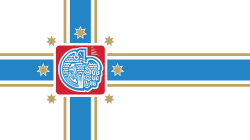





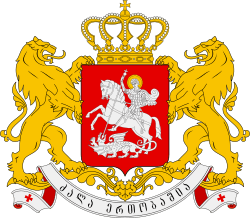
.svg.png)
